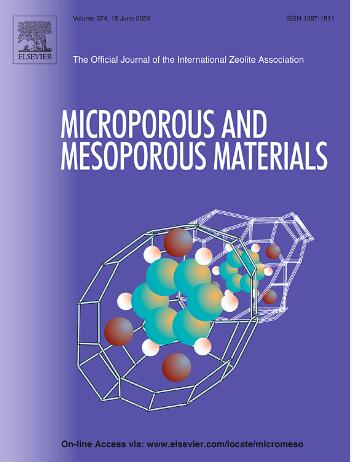Mechanism of confinement compensating for acid strength: The case of aromatic Wheland intermediate formation in zeolite catalysis
IF 4.8
3区 材料科学
Q1 CHEMISTRY, APPLIED
引用次数: 0
Abstract
The catalytic performance of zeolite is contingent upon both the Brønsted acid strength and the confinement effect afforded by the acid site over the zeolite framework. In this investigation, systematic density functional theory (DFT) calculations have been conducted to elucidate the impact of acid strength and confinement effect on the formation and stability of the aromatic Wheland intermediate over zeolite. The theoretical results indicate that an increase in the intrinsic acid strength of the isolated 8T site can effectively reduce the barrier to the formation of the aromatic Wheland intermediate and significantly enhance the stability of the arene ion within ZSM-5 zeolite. Conversely, it was observed that the activated barriers were significantly reduced when the confinement effect of the zeolite framework was taken into account, which suggests that the apparent acid strength was enhanced. In this instance, the 72T model exhibits a comparable potential energy profile to that of the isolated acidic site, with a deprotonation energy (DPE) of 275.5 kcal/mol. Consequently, both zeolite confinement effect and acidity can decrease the activation energy of the reactions, and even change the reaction pathway. Moreover, the Wheland type complex in the H/D exchange of benzene can serve as a transition state or an intermediate, depending on the strength of acidity and the confinement effect.

求助全文
约1分钟内获得全文
求助全文
来源期刊

Microporous and Mesoporous Materials
化学-材料科学:综合
CiteScore
10.70
自引率
5.80%
发文量
649
审稿时长
26 days
期刊介绍:
Microporous and Mesoporous Materials covers novel and significant aspects of porous solids classified as either microporous (pore size up to 2 nm) or mesoporous (pore size 2 to 50 nm). The porosity should have a specific impact on the material properties or application. Typical examples are zeolites and zeolite-like materials, pillared materials, clathrasils and clathrates, carbon molecular sieves, ordered mesoporous materials, organic/inorganic porous hybrid materials, or porous metal oxides. Both natural and synthetic porous materials are within the scope of the journal.
Topics which are particularly of interest include:
All aspects of natural microporous and mesoporous solids
The synthesis of crystalline or amorphous porous materials
The physico-chemical characterization of microporous and mesoporous solids, especially spectroscopic and microscopic
The modification of microporous and mesoporous solids, for example by ion exchange or solid-state reactions
All topics related to diffusion of mobile species in the pores of microporous and mesoporous materials
Adsorption (and other separation techniques) using microporous or mesoporous adsorbents
Catalysis by microporous and mesoporous materials
Host/guest interactions
Theoretical chemistry and modelling of host/guest interactions
All topics related to the application of microporous and mesoporous materials in industrial catalysis, separation technology, environmental protection, electrochemistry, membranes, sensors, optical devices, etc.
 求助内容:
求助内容: 应助结果提醒方式:
应助结果提醒方式:


